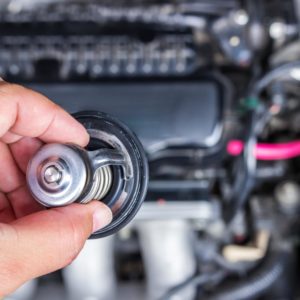Engines find it hard to start up after a cold night, and diesel engines are even worse when it comes to cold starts.
For every PSI of compression in a diesel engine, the temperature of incoming air is heated 2 degrees Fahrenheit. Diesels usually have between 450 and 500 PSI of compression, which translates to about 1,000 degrees Fahrenheit.
For every PSI of compression in a diesel engine, the temperature of incoming air is heated 2 degrees Fahrenheit. Diesels usually have between 450 and 500 PSI of compression, which translates to about 1,000 degrees Fahrenheit.
– Richard McCuistian, ASE Certified Master Automobile Technician
Because a diesel fires its mix on compression rather than using a spark, on cold starts (particularly in winter), the heat generated during compression will be absorbed by the cold steel of the head and the piston so that the diesel doesn’t ignite. Diesel fuel’s “autoignition” temperature is about 410 degrees Fahrenheit, but a cold diesel engine may be difficult or even impossible to start without some kind of added heat.
Fortunately, most diesel engines have glow plugs that heat up their combustion chambers. As an aside, Cummins diesel engines use a single electrical grid to heat the air entering the intake manifold, so they don’t use glow plugs.
Glow plugs play an important role in your vehicle’s engine performance, fuel efficiency, and emission control during cold starts.

If the powertrain control module (PCM) detects a problem in the glow plug/heater circuit “A”, its diagnostics will log a P0380 code.
What Does the P0380 Code Mean?
The Diagnostic Trouble Code (DTC) P0380 indicates “Glow Plug/Heater Circuit “A” Malfunction.”
When you start your vehicle, the PCM checks parameters, such as the coolant temperature, to see if the diesel engine is hot enough to run properly. If it detects that the engine is cold, the computer will activate the glow plugs. These plugs produce intense heat that raises the cylinder temperature, making it easier to burn the diesel fuel.
Depending on your vehicle’s diesel engine design, the glow plugs can keep running for a short time after the engine gets hot enough. This extended operation helps the engine burn the air-fuel mixture more completely, which reduces white smoke and noise.
The PCM regularly checks the performance of the glow plugs. If the computer doesn’t get the right response from the glow plug, it will set the powertrain code P0380.

P0380 on GM vehicles
GM describes the parameters for the P0380 code as follows:
- Glow plug signal voltage is less than 4 volts after ECM commands glow plugs ON; or
- Glow plug signal voltage is more than 4 volts after the ECM has commanded glow plugs OFF
Note: The definition of code P0380 may differ according to the vehicle manufacturer. Check the appropriate repair manual or repair database for the exact code definition.

What are the Possible Causes of the P0380 Code?
- Bad glow plug relay
- Stuck closed glow plug relay or short to power
- Problems with the glow plug control unit
- Faulty glow plugs
- Issues with the connectors and wires in the glow plug wiring harness
- Open fuse
- An issue with the PCM, such as software in need of an update
What are the Common Symptoms of the P0380 Code?
- Check engine light illuminates
- Difficulty in starting the engine, especially during cold starts
How to Diagnose the P0380 Code
If you’re not confident about conducting diagnostic tests on your vehicle’s glow plugs, it’s a good idea to bring it to a certified mechanic. Otherwise, you may go ahead and diagnose the issue yourself. To help you get started, here are some videos that may give you an idea of what the process might involve:
How to Fix the P0380 Code
Attempting to fix a P0380 code may become a frustrating task if you don’t have the right tools and know-how to test the glow plugs, the control unit, its relay, and its wiring harness. In most cases, it’s best to leave the job to professionals.
For DIYers with advanced technical knowledge and hands-on experience who prefer to test and replace their vehicle’s glow plugs and associated parts on their own, it will be helpful to rely on the appropriate repair manual or refer to an online repair database.
Replacing Your Vehicle’s Glow Plug Relay to Fix DTC P0380
It’s a good idea to replace the malfunctioning components associated with the code as soon as possible to prevent your engine from suffering from performance issues.
A common culprit behind this trouble code is a bad glow plug relay. Fortunately, finding a replacement relay that works with your vehicle is much easier thanks to CarParts.com.
Shop online by downloading our mobile or visiting our website. Use our vehicle selector to check for fitment, and toggle our search filters to shop according to your preferred brand or price range. Place your order through our secure payment channels, and expect your order to arrive in as fast as two business days if you place it before noon ET.
Parts are sourced from trusted brands and vetted by a team of industry professionals to ensure fit, performance, and reliability. Save big on repairs, and get the best value for your money with our low-price and lifetime replacement guarantees.
Order your new glow plug relay today!
Any information provided on this Website is for informational purposes only and is not intended to replace consultation with a professional mechanic. The accuracy and timeliness of the information may change from the time of publication.




















